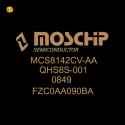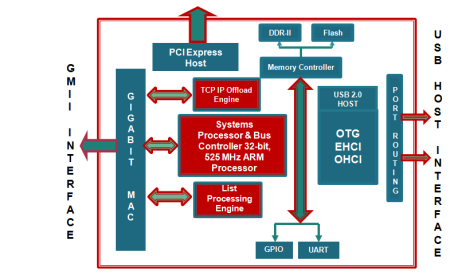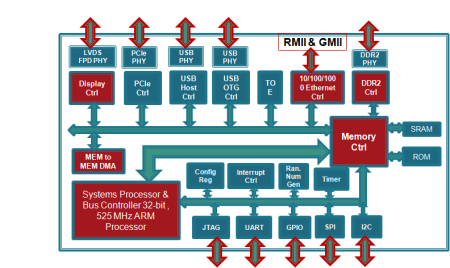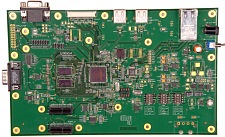TOE-equipped SoCs target home network, storage appliances
Feb 3, 2009 — by Eric Brown — from the LinuxDevices Archive — 11 views A fabless semiconductor company in India is sampling two Linux-compatible, ARM9-based system-on-chips (SoCs) for consumer-grade networking and storage appliances. MosChip's MCS8142 and MCS8144 SoCs offer PCI Express, gigabit Ethernet, TCP/UDP/IP offload engines (TOEs), and a display controller option, the company says.
A fabless semiconductor company in India is sampling two Linux-compatible, ARM9-based system-on-chips (SoCs) for consumer-grade networking and storage appliances. MosChip's MCS8142 and MCS8144 SoCs offer PCI Express, gigabit Ethernet, TCP/UDP/IP offload engines (TOEs), and a display controller option, the company says.
(Click here for a larger view of the MosChip MCS8142)
MosChip styles its SoCs as “NAPs” (network appliance processors), though that is not an acronym we expect to gain widespread traction. The MCS8142 targets consumer-grade network attached storage (NAS) devices, PC and media docking stations, home networking, and media servers. Meanwhile, the MCS8144 adds a display controller, and targets digital signage, in addition to the above applications. Both are fabricated using 130nm process technology.
Touted as “second-generation,” the chips are based on ARM9 cores clocked at 550MHz. They use an interconnect touted as offering a “point-to-point” link to each device on the system bus. An on-chip memory controller supports DDR2 RAM. There's also a dedicated TCP/IP/UDP engine, and a “dual-mode” PCI Express interface, according to the company.
MCS8142
The MCS8142, supplied in a 256-pin TFBGA (thin fine pitch ball grid array) package, includes the following functionality in addition to its CPU, according to MosChip:
- Gigabit Ethernet port
- Integrated DDR2 memory controller
- 16C550-compatible UART
- 1 x1 PCI Express port
- I2C
- SPI
- 8 GPIOs

A block diagram of the MosChip MCS8142
(Click to enlarge)
MCS8144
The MCS8144, which comes in a 292-pin TFBGA package, may be interfaced to LVDS flat panels directly, and may additionally be connected to TFT/STN displays and TV monitors, with resolutions ranging from QVGA (320 x 240 pixels) to WXGA (1280 x 800 pixels). Compared to the MCS8142, the MSC8144 also adds a second x1 PCI Express port, according to MosChip (see block diagram, below).

A block diagram of the MosChip MCS8144
(Click to enlarge)
Though it did not provide relevant product details, MosChip forwarded pictures of two available evaluation boards it is making available for the MCS8142 and MCS8144. As the pictures below show, the boards include the SoCs, a variety of real-world interfaces, and what appears to be RAM and flash memory.


MosChip's evaluation boards for the MCS8142 (left) and MCS8144 (right)
(Click either to enlarge)On the MCS8142 evaluation board (above left), for example, there's an RJ45 connector for gigabit Ethernet, two USB ports, a serial port, headers for the GPIOs, and a x1 PCI Express expansion slot. The evaluation board for the MSC8142 (above right) adds a second x1 PCI Express slot and a VGA port.
MosChip adds that it has partnered with E-con Systems, which will assist with development of Windows CE BSPs (board support packages) for the MCS8142 and MCS8144. No BSP appears to be currently offered for Linux, but the SoC is said to be compatible with Linux. Meanwhile, a second partner, IdealBT, is developing embedded Linux network applications based on the SoC for Internet appliance and NAS products, says MosChip.
Further information
The MCS8142 and MCS8144 network appliance processors are sampling today, and production quantities will be available in March, according to MosChip. Pricing for the MCS8142 is quoted as $10 in quantities of 10,000, while the MCS8144 is $15 in similar quantities.
Information on the MCS8142 and MCS8144 does not yet appear on the MosChip website, but information on the company's earlier NAPs may be found, here.
This article was originally published on LinuxDevices.com and has been donated to the open source community by QuinStreet Inc. Please visit LinuxToday.com for up-to-date news and articles about Linux and open source.